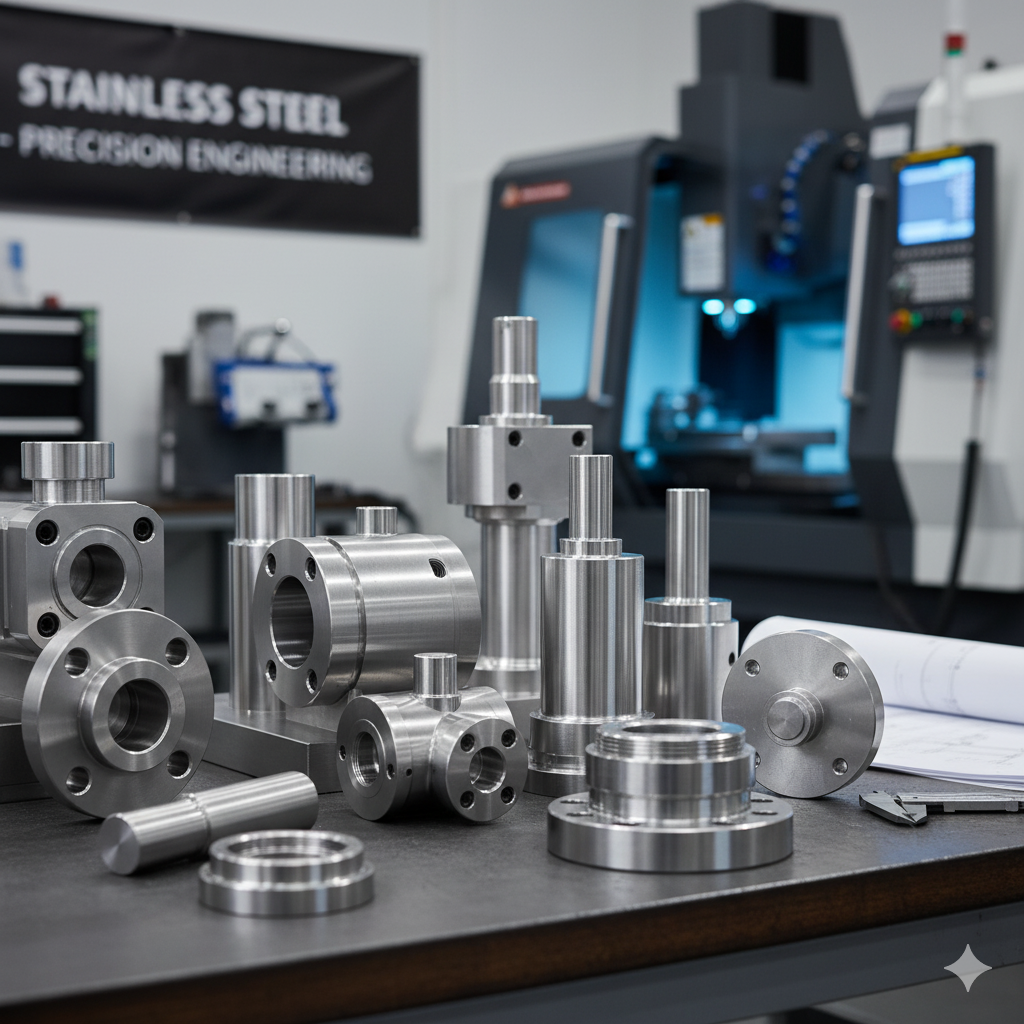
CNC Stainless Steel Machining: Strength, Precision, and Corrosion Resistance in Every Cut
When engineering teams seek components that combine durability, precision, and corrosion resistance, CNC stainless steel machining often becomes the gold standard.
From aerospace actuators to medical implants, stainless steel components must perform under extreme stress and temperature variations while maintaining exact dimensional accuracy.
This article explains how advanced CNC technology, precision tooling, and material expertise allow Liqin to produce stainless steel parts that meet the most demanding global standards.
The Pain Point: Machining a Material That Refuses to Compromise
Stainless steel offers impressive mechanical and chemical properties—but it’s also one of the most challenging materials to machine.
Manufacturers frequently encounter:
-
Rapid tool wear due to high hardness and low thermal conductivity.
-
Material work-hardening, causing cutting resistance to increase mid-process.
-
Burr formation and surface distortion on thin-walled components.
-
Heat retention, leading to dimensional inaccuracies.
-
Limited production throughput without proper cooling and feed optimization.
These issues can lead to inconsistent quality, higher costs, and delivery delays. Overcoming them requires expertise in both metallurgy and CNC control.
The Engineering Logic Behind CNC Stainless Steel Machining
Stainless steel machining depends on balancing three variables: heat control, tool geometry, and feed rate management.
By leveraging multi-axis CNC systems, real-time compensation, and optimized cooling strategies, precision can be maintained even under heavy load.
Key Technical Principles:
-
Low Cutting Speeds: Reduce heat buildup to avoid material work-hardening.
-
Optimized Tool Coating: Carbide and TiAlN-coated tools resist abrasion and oxidation.
-
Coolant Integration: High-pressure fluid systems dissipate heat efficiently.
-
Multi-Axis Stability: 4–5 axis machining allows smooth contouring and reduced repositioning.
-
Digital Feedback: Temperature and torque sensors adjust feed rates automatically.
This synergy between machine intelligence and metallurgical precision defines Liqin’s stainless steel machining excellence.
Standard vs. Precision CNC Machining: A Technical Comparison
| Parameter | Standard Machining | CNC Stainless Steel Machining |
|---|---|---|
| Tolerance | ±0.05 mm | ±0.005 mm |
| Tool Life | Short | Extended with advanced coatings |
| Heat Control | Manual | Real-time coolant management |
| Surface Finish | Variable | Ra ≤ 0.8 μm |
| Material Waste | High | < 3% |
| Traceability | Paper-based | Digital batch tracking |
Precision CNC machining doesn’t just improve tolerance—it guarantees repeatable quality and reduces long-term cost by optimizing every parameter in the process.
The Liqin CNC Process: Turning Strength into Precision
Liqin’s stainless steel machining integrates design, material analysis, and automated production to deliver consistent results every time.
Process Overview:
-
Design Evaluation – Review of 3D models for machining feasibility and tolerance validation.
-
Material Testing – Verification of alloy composition (304, 316, 410, 420, etc.) and hardness control.
-
CNC Programming – Multi-axis toolpath simulation ensures collision-free machining.
-
Machining & Cooling – Optimized spindle speeds and coolant pressure for heat management.
-
Surface Finishing – Polishing, passivation, or electropolishing for corrosion resistance.
-
Inspection & Traceability – CMM and surface roughness measurement before packaging.
This closed-loop process allows Liqin to maintain both aesthetic finish and structural integrity—qualities essential for critical stainless steel components.
Advantages of CNC Stainless Steel Machining
1. Corrosion Resistance:
Perfect for environments exposed to moisture, salt, or chemical agents.
2. Superior Strength-to-Weight Ratio:
Ideal for components that require both compactness and load capacity.
3. Dimensional Precision:
Achieves sub-micron accuracy across complex geometries.
4. Long-Term Durability:
Withstands stress, vibration, and temperature variations over long service cycles.
5. Aesthetic Finishing:
Supports mirror polishing, bead blasting, and brushed textures for visible components.
By combining advanced tooling with real-time data monitoring, Liqin ensures every stainless steel component performs with both functional and visual excellence.
Applications Across Industries
| Industry | Component Type | Material Grade | Key Property |
|---|---|---|---|
| Aerospace | Brackets, actuators | 17-4PH, 15-5PH | High strength, fatigue resistance |
| Automotive | Shafts, flanges, fasteners | 304, 316 | Corrosion resistance |
| Medical | Surgical handles, implants | 316L, 420 | Biocompatibility |
| Marine | Pumps, connectors, valves | 316, 904L | Saltwater durability |
| Energy & Equipment | Gears, clamps, mounts | 410, 420 | Heat and wear resistance |
Stainless steel’s versatility makes it indispensable across high-stress and high-precision industries.
Selecting the Right Machining Approach for Different Requirements
Different applications demand different approaches to stainless steel machining.
Here’s how to align machining strategy with your specific project goals:
-
High-Corrosion Environments (Marine, Food Processing):
Choose 316 or 904L grades with full passivation finishing to maximize resistance. -
Medical and Biotech Applications:
Opt for 316L stainless steel with electropolished surfaces for smooth, hygienic results. -
Heavy-Duty Industrial Use:
Prefer 410 or 420 martensitic grades with hardened surface treatment for wear resistance. -
Precision Components (Aerospace, Robotics):
Select 17-4PH or 15-5PH alloys for their excellent strength-to-weight balance.
Liqin tailors machining strategies to meet these performance needs while maintaining efficiency, accuracy, and cost control.
Frequently Asked Questions
Q1: Which stainless steel grades are best for CNC machining?
Grades 304, 316, and 17-4PH are most common, offering excellent machinability and corrosion resistance.
Q2: How does Liqin manage tool wear when machining stainless steel?
We use TiAlN-coated carbide tools, optimized feed rates, and controlled coolant pressure.
Q3: What surface finishes are available?
Options include polishing, bead blasting, passivation, and electropolishing.
Q4: Can you handle both prototypes and production volumes?
Yes. Our system supports small-batch prototypes and full-scale OEM production.
Q5: What industries does Liqin serve?
Aerospace, automotive, medical, marine, and industrial equipment manufacturing.
Engineering Precision That Endures
CNC stainless steel machining is about more than hardness—it’s about mastering precision under pressure.
With advanced toolpath control, metallurgical expertise, and integrated finishing systems, Liqin transforms one of the toughest materials into products that define strength, consistency, and endurance.
Every component reflects our commitment to accuracy and reliability—qualities that help manufacturers maintain global standards of performance.
To discuss your stainless steel machining project, visit the Homepage or contact our engineering team via the Contact Us page.

